The Isaac Lord buildings (the continuing story)
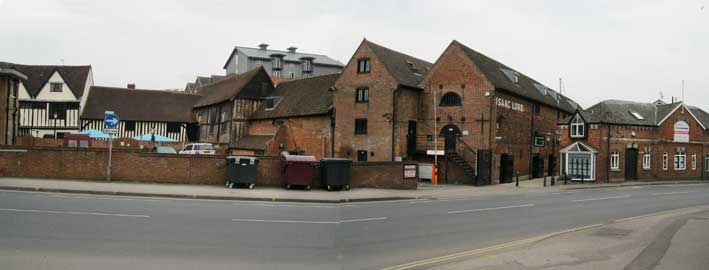 2013
composite image
2013
composite image
This fascinating complex
of buildings behind the Tudor merchant's house at 80
Fore Street was
put onto the market in 2004, including the public house on the Wet Dock
waterfront (initially called The Malt Kiln). By 2009 the buildings from
the courtyard down to the dockside had become a bar/restaurant business
called "Isaac's". The painting in pencil,
watercolour
and gouache (below) is by Alan Waddington Bellis (1883-1960) and shows
its
rather dilapidated condition in 1927 (Ipswich Museums' Collections).
The Saleroom is so-called because it is thought that customers came
there to inspect the merchant's woollen cloth before it was exported.
The Crossway or crosswing which stands at right angles to the Saleroom
dates from between 1530 and 1550. The herringbone brickwork infills and
the heavy windbraces of the oak roof mark this as a building of high
status. The waggon entry on Fore Street leads to the courtyard,
under the Crossway and down to a private quay on the Wet Dock where
ships loaded Suffolk woollen cloth onto ships bound for ports in the
Low Countries and perhaps further afield.
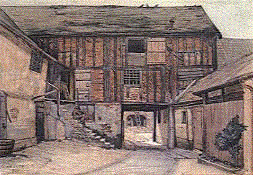 Lord's Granary, Ipswich,
1927
Lord's Granary, Ipswich,
1927
The river would have come up through the walkway to the
bottom of the steps.
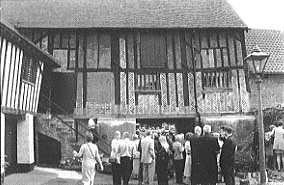 Lord's Crossway and
Saleroom, 2004
Lord's Crossway and
Saleroom, 2004
The photograph above (taken from the Ipswich
Society Newsletter,
Issue 154) provides a fine comparison. The gathering marks the award by
the Ipswich Society to owners Stuart and Gina Cooper, architect Anthony
Rossi
and
builder John Hogg of an Award of Distinction for "Refurbishment of
the Saleroom and Crossway" on 12 November, 2003. The major structural
repairs were started by the Coopers over twenty years ago to rescue the
redundant
buildings from decay. Ipswich Borough Council and its Conservation
Officer,
Bob Kindred, have assisted in bringing parts of the site into useful,
rate-generating
activity. The west side of the site has been converted into office
spaces
and an art gallery (The John Russell Gallery in Wherry
Lane). English Heritage grants aided the long and extensive
restoration
of the buildings shown here and planning permission was obtained in
2003
to create a restaurant in the Grade II listed east warehouse.
John Lee has been kind enough to send these
photographs of a pair of rather good watercolours of the complex "dated
July and August 1924... They are by the artist W.G. Merrick... I noted
a similar 1927 painting in the Ipswich Museum."
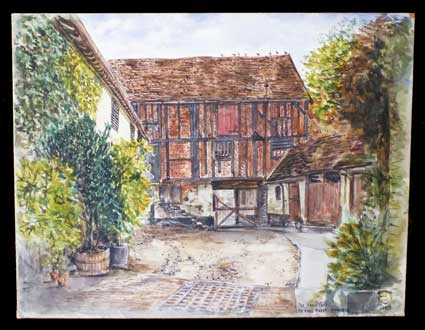
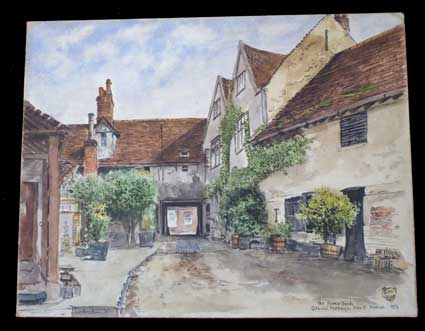 Images
courtesy John Lee
Images
courtesy John Lee
The left painting is inscribed: 'The Home Yard, 80 Fore Street,
Ipswich, 1924.' It shows the crossway seen from under the carriage
entrance on Fore Street with rather nice plants in tubs near to a
cobbled surface, a large gate across the entry beneath the crossway and
external steps to the left.
The right-hand painting is entitled: ''The Home Yard,
Cobbold's Maltings, Fore Street, Ipswich, 1924.' It is the reverse
view, from beneath the crossway, of the merchants' house to the right
with storage buildings across the yard to the left and the carriage
entrance to Fore Street, with part of the Lord Nelson public house
visible over the road.
(Both paintings have 'GOD first' in a golden shield.)
The Cobbold water pump
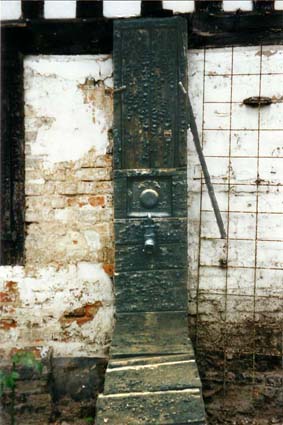 An
enhanced view of the pump during refurbishment in 2004.
An
enhanced view of the pump during refurbishment in 2004.
An independent developer opened these buildings as a
bar/restaurant in 2009. Visitors to "Isaac's"
will have the treat of seeing the interior details, sensitively
restored of this famous survivor in the history of the dock and of
Ipswich's maritime heritage. We know that John
Cobbold - a very famous local name
because of the dominance
of the Tolly Cobbold brewery on Cliff
Quay - once lived in the Isaac
Lord
house. One piece of evidence for this is the fire-damaged water pump
(above)
which
stands against the Saleroom wall in the courtyard reached via the entry in Fore Street,
opposite the Lord Nelson public house (shown here).
See Links for the Village
Pumps
website for a national overview of these surviving curiosities. This courtyard has, by 2010, become an area accessible to
the public (via
the "Isaac's" bar/restaurant) and the characters above the tap can be
seen in these June, 2010 images:
'I ... C
18 ... 02'
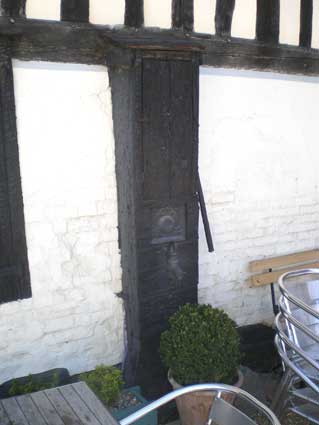

The "I" is assumed
to be a period character for 'J' as in 'John Cobbold'. Robert Malster's fine 'Ipswich: an A to Z of local history'
(see Reading List) tells us of three notable
men of this name. The first John Cobbold (1746-1835) was the third
generation of the brewing family; he built Holywells Mansion around
1814. The second John Cobbold (1774-1860) was his eldest son and he
married one of the Chevallier family of Aspall and he took a leading
role in bringing the steam railway to Ipswich. The third was, in turn,
his eldest son and was known as John Chevallier Cobbold (1797-1882) and
was involved with his father in the Eatern Union Railway; he also
represented Ipswich as Member of Parliament for twenty years, was a
leading light in the planning of the Wet Dock and was Mayor of
Ipswich
in 1842: the year the dock opened. As this last 'John Cobbold' would
have been only five years old in 1802 (and would really need the
initials 'J.C.C.'), we wonder if the pump lettering celebrates the
second 'John Cobbold' who would have been twenty eight in 1802.
However, the first 'John Cobbold' would have been fifty-six when the
pump panel was dated, so it could have been him.
During the Cobbold families' ownership of the ‘Isaac Lord’
complex, buildings were used as maltings and the Wherry Inn, a local
pub, was on the quay. Isaac Lord, a local businessman, bought the site
in 1900, and in 1930 Reginald (Reg) Cooper joined Isaacs Lord's
business, helping grow the firm's corn and coal interests, eventually
becoming the owner of the property. Isaac Lord died in 1942 but
his daughter lived in the merchant house fronting Fore Street until
1976. Once the business had ceased trading, the Cooper family
eventually worked hard to gain funding and begin the restoration of
parts of the site. They enabled the building fronting the dock to be
used as a temporary maritime museum in the 1980s. The whole complex was
eventually purchased by Aiden Coughlan, who has taken the sympathetic
restoration and refurbishment of Isaac Lord's as a bar and restaurant
business to its present success. Upper rooms house a restored machine
for crushing cattle-cake and the old (1960s) Lloyd's Bank building is
now the Briarbank bar and brewery.
We don't know of any other water pump surviving in
Ipswich and certainly nothing to rival the Ransomes
marvel in Hadleigh.
See also our Lettered castings
index page.
Around 1900, Isaac
Lord bought the buildings and traded in corn and coal until
the
1980s,
leaving his name prominently painted on several walls to be read by us
today.
Related pages:
The Question Mark
Christie's
warehouse
Bridge
Street
Burton Son & Sanders / Paul's
College Street
Coprolite
Street
Cranfield's
Flour Mill
Custom House
Trinity
House buoy
Edward
Fison Ltd
Ground-level dockside furniture
on: 'The
island', the northern quays
and Ransome's
Orwell Works
Ipswich
Whaling Station?
Neptune Inn
clock, garden
and interior
The Island
John Good and Sons
Merchant
seamen's memorial
The Mill
Nova Scotia
House
New Cut East
Quay
nameplates
R&W Paul malting company
Ransomes
Steam
Packet Hotel
Stoke
Bridge(s)
Waterfront
Regeneration Scheme
Wolsey's
Gate
A chance to
compare
Wet Dock 1970s with 2004
Wet Dock maps
Davy's
illustration of the laying of the Wet Dock lock foundation stone,
1839
Outside
the Wet Dock
Maritime Ipswich
'82 festival
Home
Please email any comments
and contributions by clicking here.
Search Ipswich
Historic Lettering
©2004 Copyright
throughout the Ipswich
Historic Lettering site: Borin Van Loon
No reproduction of text or images without express written permission
 2013
composite image
2013
composite image Lord's Granary, Ipswich,
1927
Lord's Granary, Ipswich,
1927 Lord's Crossway and
Saleroom, 2004
Lord's Crossway and
Saleroom, 2004

 An
enhanced view of the pump during refurbishment in 2004.
An
enhanced view of the pump during refurbishment in 2004. 
